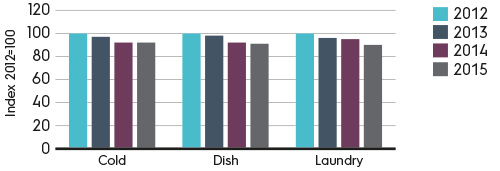Electrolux will improve the energy and water performance of our appliances, raising the bar for product efficiency across the world.
| The roadmap to 2020 | Next steps | |
|---|---|---|
| Be a leader in product efficiency in our most important markets by 2020. | Preparing for energy labeling and raised energy-efficiency standards in the US and Brazil, and for Professional. | |
| Continue to focus on sustainable innovation, including energy efficiency. | Further integration in product R&D. | |
| Continue to grow the market for efficient products through marketing campaigns that highlight sustainability. | ‘For the better’ consumer engagement campaign to drive uptake of efficient solutions. |
On track
Additional effort is required
Off track
Work has not yet begun
Strong focus on product efficiency has proved a profitable strategy for Electrolux in key markets, especially in Europe. This year, the Group worked to make sure that our approach is applied in processes across product categories; all to make water and energy efficiency a defining feature of the product offering.
Year on year, Electrolux has been demonstrating the value of efficient products. In 2015, the global green range of our most energy- and water-efficient products accounted for 20% of total units sold and 32% of gross profit for consumer products. Now, this priority is anchored in every major product line in key markets. Efficiency is a priority across all product categories, and each major category has 2020 targets in place for its markets, as well as indicators to track progress.
To date, greater product efficiency has contributed 22% to our progress on the Climate Target 2020.
The global approach to product design and modularization are crucial for stepping up the level of ambition across the product categories. Over the years, Electrolux has been investing about a third of its R&D spend on product efficiency – this year, approximately SEK 1070m – and increasingly, global projects are in the pipeline. Every year, we communicate how efficiency has improved in each product category by measuring our fleet average.
The profitability and choice of products going to market is determined on the local level, based on energy-efficiency requirements and consumer demand. Of our key markets, Europe, US, Brazil and some Asia-Pacific countries currently have efficiency requirements in place, with varying levels of ambition. According to our own 2014 consumer research, engagement levels are high in Europe and are increasing in the US.
In Europe - representing 30% of total Group sales - energy efficiency has improved by an average of three percent per year since 2012 (see graph EU Fleet Average below), and Electrolux is well established in the efficiency race there. Our leadership position is also evident in fabric care and across markets for food preservation, both of which are high-volume categories.
Engaging in conversation directly with consumers on the value of using appliances optimally and efficiently will help us overcome these challenges. This will begin with a communications campaign in Europe in 2016.
Electrolux reports annually on its green range of energy-efficient products to measure sales and profitability of efficient products. In addition, product-efficiency targets and performance indicators (KPIs) are integrated into our product generation planning. The latter is supported by analysis of the regulatory landscape, market position and energy-efficiency improvements.

In Europe, Electrolux continuously improved its energy efficiency across three product categories in 2015. The energy index is set at 100% for 2012.
20%
Consumer products with the
best environmental performance
accounted for 20% of total units sold
32%
and 32% of gross profit
The global green range accounted for 20% of total units sold and 32% of gross profit for consumer products.